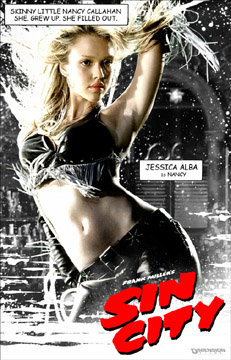 (READ PART ONE HERE!)
(READ PART ONE HERE!)
Robert Rodriguez actually left the room for 10 minutes only to come back with a new group of actors for the second Sin City press conference. Benicio Del Toro and Jessica Alba were not as lovey duvey as the previous group. They just got right back down to business for more in depth probing Sin City questions.
Q: Jessica, your character was topless in the comic book. Why did you want to play the character and why wouldn’t you do it topless?
Jessica: She was bottomless too. I wanted to do this movie because Robert Rodriguez was directing it, first and foremost. I didn’t really know it was a comic book when I read the sides, when I saw that he was directing something. I just tell my agent every month what is Robert doing? I want to do something with him. And Lee, one of my agents, has a really relationship with Robert and said, “You got an opportunity.” And I was like, “Excellent.” So I took that opportunity and ran with it. I auditioned the old fashioned way, went in for the casting director, put myself on tape and he had to approve. And it was like a week of “Does he think I suck? I just don’t want him to think I suck. I don’t care if I get the role. I just don’t want Robert to think I suck.” And he didn’t think I sucked and he came down and I read with him and I looked at the, by that time, I looked at the graphic novel and I saw all the pictures. I then found out she was a stripper and was bottomless and topless and, nudity was an option. We could have done it if we wanted to, I just felt too—
Q: Was it really an option?
Jessica: It absolutely was an option. Robert said that we could do it if we wanted to and obviously it would have been more authentic. But I felt like dancing around with a lasso and chaps was gonna be sexy enough. I think being nude, for me, would have been distracting and I really couldn’t be bottomless for my dad. He would really—I don’t know, he would disown me. He would freak out.
Robert: We retained the sexiness of it and people, like in the comics, the world in the comics, they just think Nancy is the sexiest person in the world and you did that. That’s all we needed to get across.
Q: Was your relationship with Willis’ character weird or uncomfortable with him as a father figure?
Jessica: Nancy doesn’t think of him as a father, she thinks of him as her knight in shining armor. So I just came at it from that point, and she just waited till she was old enough to really be in love with him and have that relationship completely. I think she always looked to him as her soul mate from the beginning. She’s kind of an old soul from when she’s a little child, talking to him and reasoning with him, saying that she’s trying everything and she’s going to write him and so, I didn’t think it was creepy at all.
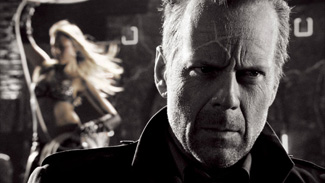 Robert: Yeah, it’s a great love story because he doesn’t realize she’s grown all those ages, she’s like the only person there for him while he’s in prison and he comes out. Frank got the idea cause he was at his mother’s house and there’s this beautiful woman walked in, and there’s the kitchen, and he’s like, “Oh my god,” then she turns around and says, “Hi, Uncle Frank!” And he’s like “Oh my god, my little niece is grown up.” He felt like such an idiot for looking at her but she became a woman in front of his eyes. He hadn’t seen her in years and that’s where he got the idea for. And I had some of that when I first met you, you came over to the set, you were like 16, she was kinda dorky, really kinda thin. And I was like, “She’s so cute.” And I was really looking at her cause she was an Alba and there were very few Latin actresses, and I was really watching her from then on hoping that she would still be around for another movie. And then, now she’s like, it’s almost like that feeling, I remember when she was [little].
Robert: Yeah, it’s a great love story because he doesn’t realize she’s grown all those ages, she’s like the only person there for him while he’s in prison and he comes out. Frank got the idea cause he was at his mother’s house and there’s this beautiful woman walked in, and there’s the kitchen, and he’s like, “Oh my god,” then she turns around and says, “Hi, Uncle Frank!” And he’s like “Oh my god, my little niece is grown up.” He felt like such an idiot for looking at her but she became a woman in front of his eyes. He hadn’t seen her in years and that’s where he got the idea for. And I had some of that when I first met you, you came over to the set, you were like 16, she was kinda dorky, really kinda thin. And I was like, “She’s so cute.” And I was really looking at her cause she was an Alba and there were very few Latin actresses, and I was really watching her from then on hoping that she would still be around for another movie. And then, now she’s like, it’s almost like that feeling, I remember when she was [little].
Q: Jessica, you have three major movies in the next couple months. Is this year going to change things for you?
Jessica: I’ve been doing this for 11 years so it definitely isn’t an overnight thing and if people then know about me, I don’t entertain or act for myself or else I would just act in front of the mirror, so I actually like having an audience and people being affected by stuff that I’m in. I love entertaining and they all happen to come out this year and the more, the merrier.
Robert: There’s nothing more satisfying than— because she’s already been in Dark Angel and people already knew who she was so she was a great choice but to be there, having her on the set, having her dancing, and photographing her, taking this picture and then when I had to go to Comicon and create these pictures for the actors to sign, I picked this picture and I said “She’s amazing.” And just seeing her explode there, part of seeing that happen in front of your eyes and then just seeing her go to another level and it was just really exciting. And working with somebody like Benecio who’s got an Oscar, who’s been there and done a lot of things, and yet doing new things with someone like that, that was really incredible too. It was finding how much talent people have and how much you can explore and always rediscover, or discover for the first time. When I got Benecio, he was looking at the books and said, “I want to look more like this guy in the comic. I want to get a nose piece and a chin piece.” I said, “Hey, go to the magic man, go to the make up guy, he’ll put that stuff on you.” He got the character so quick.
Q: Benicio, how did you approach the role and being directed by Tarantino?
Benicio: I was approached by Robert. I think we met at the Vanity Fair thing, the Oscar party, and she said something really strange, like “Don’t cut your hair.” And my hair was pretty long. He goes, “Don’t cut your hair.” I go, OK. Then I met him here at the Four Season and he showed me, he had done a trailer or the opening sequence of the movie and it just looked amazing.
Q: Were you familiar with the books?
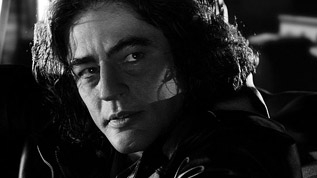 Benicio: I wasn’t familiar with the books. I was familiar with Frank’s work in Batman and stuff and since then, my preparation was really talking to the Wizard about— [Robert] got that nickname, I gave him that nickname. We just walked in and everything was green and I had seen how it looked already because he had shown me the beginning of the movie, the opening sequence. It was like being in the office of the Wizard of Oz thing.
Benicio: I wasn’t familiar with the books. I was familiar with Frank’s work in Batman and stuff and since then, my preparation was really talking to the Wizard about— [Robert] got that nickname, I gave him that nickname. We just walked in and everything was green and I had seen how it looked already because he had shown me the beginning of the movie, the opening sequence. It was like being in the office of the Wizard of Oz thing.
Robert: He worked on it. It was interesting to watch his process. He worked on it with the book, he got the makeup. He showed up on the set and we had three jacket choices for him. That was part of getting into the characters, putting on the costume and he wanted to look as much like the character as possible. Everybody did because they were really playing a character and they could cut loose and we did one test of him, he put on his jacket, the one he liked, we put him in front of the camera. This is the test on the green, and I’m going to put it on the DVD, because he walks out and turns around and is like he was already in the character. He just walked out and I was like, “It’s him.” His eyes were doing this really spooky thing and Frank was getting creeped out. We hired Benecio, but somehow we got Jackie Boy. It’s the best thing in the world to see an actor transform and within a day, we shoot very fast.
Benicio: Yeah, the Wizard goes really fast. He makes it easy and cheap.
Robert: That’s the Latin way. Faster, cheaper, better. He’d come in and he’d have half a day to find that character. He did pre work, but he showed up, put on the costume, and he’s doing it. That’s what’s so great about these actors is that they came in—
Benicio: You know what happened, you trust. You just trust and you throw yourself in and it becomes a rehearsal that becomes glorified in a way.
Q: What about the sequence where you’re a talking corpse head?
Benicio: That’s when Quentin came in and what do you call it, the special guest director?
Robert: Yeah. But you guys flowed with it. You’d think it’d be weird, with suddenly a new director coming but the sequences all kind of stand alone. They were all prepared for anything.
Benicio: We sat down and we talked about it. Is it a voice over? Is the character going to really talk? And Quentin talked about, “Well if you talk like this, we lose the voice over, come back down.” It was all done there on the spot.
Robert: The coolest thing is I kept the camera rolling so I’ve got a lot of that footage. There’s one 16 minute take where I just kept rolling from the position of the real camera, not like behind the scenes, the real camera. So you are just like, you get to see all process. You actually get to see Quentin come into frame and give you all direction, and you’re like “Aren’t we supposed to-oh it was pretty good, we’ll just improvise this little scene.” You guys were just going off.
Benicio: It was like organized chaos.
Robert: You guys were talking all over the place and it was just brilliant. People are going to learn a lot from that. I’m going to put that on the DVD. An uninterrupted 16 minutes and you’ll see pieces that we used and you’ll see a lot in between with Quentin coming in and being like “No, I think we it should be like this.” On camera, FX guys coming in and fixing your neck.
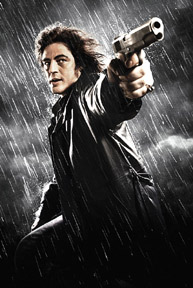 Benicio: We had a great group of FX guys.
Benicio: We had a great group of FX guys.
Robert: Seeing you guys be that creative on the spot and we’re rolling. We’re not cutting. You hear the camera guy and the assistant director going, “You’re still rolling,” and the sound guy going “We need to change the battery.” While we were still rolling, you guys were just being creative.
Benicio: The clock was ticking the whole time. You could hear it.
Q: You mentioned the Latin way, what is the significance of being Latin in Hollywood?
Robert: What’s cool about this is, someone was just asking me, “What’s the difference between now and when you started with Latin women in Hollywood?” I thought, when is started, I had to go find a Salma Hayek. There were no Latin actress working in the industry. Antonio came from Europe and was working on the Almodovar movies. But it was very hard here because studios were afraid that if we cast the Latin people, people are going to think the character is Latin and it was just a very weird time. So I had to break these people by putting them in movies that were just popular entertainment movies like Desperado, that is an action film, movies like Spy Kids, where the kids were Latin but that’s not part of the story. It really helped change thing. Wherein this movie, I’ve got Benecio, I’ve got Jessica, I’ve got Rosario Dawson. There’s a lot of Latins not playing Latin roles. They were just hired ’cause of their talent and ’cause the characters they are playing weren’t Latin characters and I didn’t even think about it, “How did I get so many Latins in this movie? There weren’t that many Latin characters.” It’s because you don’t seem as being that labeling, you just go for the best talent possible and it’s about deciding about this time period now.
Jessica: I don’t know Benecio’s experience, but it’s a lot different for me because I only used to get breakdowns for Maria, the Janitor’s daughter messing around with the white kid and it was such a classist bizarre thing ‘cause I grew up in the United States. My mother’s white, my father’s Mexican and my father is very dark and my mother is very fair and I came out how did and they always want to pigeonhole you and it’s bizarre and we’re just people living in society. And I never think about it until people make me think about it. And this industry has definitely made me think about me being a Latin girl, up until I was 18 and I did Dark Angel and Jim basically, “You are the future of the race.” And that basically what Dark Angel was where you are just a mixture and you’re not going to talk about it. It’s done and you are just a human being going through the struggle of whatever you are going through on your journey. Now it’s very liberating working with people that aren’t going to pigeonhole you as the janitor’s daughter.
Benicio: I also think that not only in the acting, but there’s a lot more filmmakers than probably when you started. We were from the same class. There’s a lot of Latinos right now, a lot of filmmakers and writers that are Latin too.
Robert: And they aren’t doing necessarily Latin work.
Benicio: Exactly. And that adds up to that pool.
Q: Did the green screen let you be more creative?
Benicio: It reminded me of theater. I trained as a theater actor and you had a bare stage and you had to pretend, one prop and you are in the middle of 8th Ave. and traffic is just going by. So it reminded me a little bit of that and that made it fun, going back to basics in some ways for me.
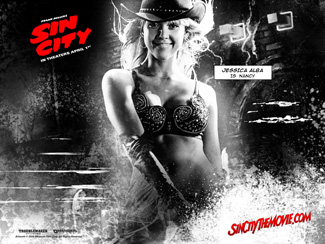 Jessica: I’m not very experienced in theater. The only training I ever had was David Mamet’s theater company, the Atlantic Theater company. And that’s all I did was go on these little stages and imagine things, but they were in small rooms so the difference is you still had to shout and project your voice, but everything was little bit bigger and with Robert, it’s very specific. He fine tunes your performance so it’s kind of a marriage of film and theater I felt.
Jessica: I’m not very experienced in theater. The only training I ever had was David Mamet’s theater company, the Atlantic Theater company. And that’s all I did was go on these little stages and imagine things, but they were in small rooms so the difference is you still had to shout and project your voice, but everything was little bit bigger and with Robert, it’s very specific. He fine tunes your performance so it’s kind of a marriage of film and theater I felt.
Q: What are the challenges of working from a comic?
Robert: You’d do different things. Sometimes I’d ask Frank, “You completely jumped screen direction here. Suddenly you—“ And he’s like, “Oh, that’s the way you lay out the wording. Judging where things lay.” Oh, that makes total sense, you have to lead the eye to tell the story that way, wherein editing and filmmaking, you have to almost go left from right and make sure when you cut, you don’t have a different, disorient the audience in any way. You can do that in comics, you can’t do that in movies. It’s just some adapting stuff to play and that’s kinda why we shot on green screen cause you put in the background and you strip it to its bare essentials so that you are always focusing on the actor or the character or whatever it is you really wanted to draw attention to and not have this over stimulus to have them shoot on a real set. Like if I shot Jessica now, this way against you, you all would be really distracting to them on a set. Where if we shot against a green screen, I could pick and choose which faces we’re gonna see, how much of anything we’re gonna see, and you can do close ups ideally on everything in the way its composed and that’s the beauty of Frank’s work and what I wanted to do with the cinema so it became very specific. Sometimes, you felt like you were in a theater stage then I would come in and be like, “Well you kind of have to do this because of the way we are laying it out.” It became very specific to the way down to like an eye blink or something.
Q: How did it affect the actors’ processes to take direction from both Frank Miller and Robert?
Benicio: One at a time. That’s it basically. I’m attentive to like put a face with the director. I for the most part, I turn to the wizard, cause he hired me. But I did have conversations with Frank, and Frank did have input on stuff. A lot of stuff.
Q: What kind of stuff?
Robert: Just knows so much about the characters.
Jessica: The character, like the backstory.
Benicio: Also like, “Hey, you know, maybe you should have a cigarette here, because we’re doing, we already, you know we’re doing the scene where my head goes in the toilet with the cigarette on” and “ok, so I’ll pull out the cigarette here, on this moment here.” You know, stuff like that. And from that to the background of the character. So, that was no problem whatsoever.
Jessica: It was very self-indulgent I think, because we just kind of got to talk each director’s ear off about our characters, and we kind of really like talking about characters we play and ourselves because we’re all kind of narcissistic.
Robert: There were some things that I knew how to answer, and some things I knew that “oh we have to go to Frank for that. I don’t know the answer to that, let’s go find out, I want to know. Hey Frank, how come you did this?”
Jessica: So what happened when…?
Robert: I explained to Frank, sometimes being a good director is just being a good audience. You don’t really have to go in and tell them all the time, “Do this do that do this do that”. Sometimes you just want to create that environment where they feel safe enough to do things that they’re going to suprise you. We had such terrific actors, unless we had something really specific we wanted or needed, it was really just seeing them bring it to life. Having material, the material is very self-evident, they’re just bringing it to life, and that’s what you want to see. You don’t really want to get it the way of that. So you don’t want to have to direct, necessarily, if you don’t need to.
Q: Going from Spy Kids to this, how do you choose what you want to direct when you pick a project?
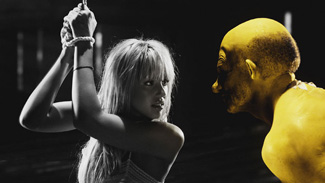 Robert: It just depends on how it grabs you. It’s got to be something that excites you. That’s why I pursued Frank just like a wild dog, trying to find him so we could do this movie. Because once I got into my head that this it was possible and I did a test and I saw what it was looking like, I knew I wouldn’t get this excited about another project for a long time. I had to hunt him down and find him and convince him somehow that we were going to do this movie, cause I could already see it and I wanted to do it, really bad. So, it just felt right. That’s why when people get in my way, the DGA goes "Oh you can’t do a movie like that," "Well I’m leaving". It’s like a train that’s rolling and everyone jump aboard ‘cause it’s just too new, it’s too right. And it feels like that way for other things. The Spy Kids movies as well. It was a way to do something about my family in a way that was entertaining, by just making them spies. My family as spies basically. The bad ideas and the ideas you don’t get excited about fall away, and the ones that come forward are the ones that get your blood pumping, that get your heart pumping. And the ones you can’t sleep until you do them, those are the ones that keep me up all night; keep me working.
Robert: It just depends on how it grabs you. It’s got to be something that excites you. That’s why I pursued Frank just like a wild dog, trying to find him so we could do this movie. Because once I got into my head that this it was possible and I did a test and I saw what it was looking like, I knew I wouldn’t get this excited about another project for a long time. I had to hunt him down and find him and convince him somehow that we were going to do this movie, cause I could already see it and I wanted to do it, really bad. So, it just felt right. That’s why when people get in my way, the DGA goes "Oh you can’t do a movie like that," "Well I’m leaving". It’s like a train that’s rolling and everyone jump aboard ‘cause it’s just too new, it’s too right. And it feels like that way for other things. The Spy Kids movies as well. It was a way to do something about my family in a way that was entertaining, by just making them spies. My family as spies basically. The bad ideas and the ideas you don’t get excited about fall away, and the ones that come forward are the ones that get your blood pumping, that get your heart pumping. And the ones you can’t sleep until you do them, those are the ones that keep me up all night; keep me working.
Q: Robert, do you feel that you owe a debt to Sky Captain, and do you see this technique as the future of movie-making?
Robert: They were kind of both at the same time. I’d just done a bunch of movies on green screen. I’d done the Spy Kids that even the props weren’t there, because it was all simulated from the game. Even though they said that was the first movie done on green screen, I actually already had been doing that. But when I did Sin City, I hadn’t seen any materials on Sky Captain. I didn’t really know they were doing a green screen movie with HD. I had already been doing that for a while. I shot the test and I went and showed Frank the material and, it’s very different because we were shooting on green screen not just to save money, which is kind of why they were doing that, but it was really the only way we could capture these images and get that black and white style. If you shot it in a real environment, all these things just go grey, because they’re all midtones. You have to isolate the actors from the background in order to create that very stark black & white, to create a black & white that you’ve never seen before, because if you watch a black & white movie, it’s really grey and white, because of all the midtones. And we had to get rid of all of those, the way Frank did with pen and ink. So, I realized this is going to be a total exercise in things I’ve been doing. That’s why I felt comfortable doing it, ‘cause I’d already done all this stuff as a photographer, as an effects supervisor, coming up with these ideas.
Q: This is for Benicio and Jessica. After doing all the work, can you talk about seeing yourself in that environment the first time, the first time you saw how the wizard put it all together for you, and can you also say if you’ve got a favorite scene from the movie?
Benicio: You know, it met the expectations when I saw the movie. Surpassed it. You know what happens when you’re in a movie, for me, like I just do come in and work for five days, and I’m out. We just basically know one story. We usually look, when I see a movie, is the other stories that attract me more than my story. I’m looking at my story going like "Oh, no, ooooh". But, it’s the other stories and it’s just hard to pick one moment. I really enjoy the under water stuff. I don’t know, it was something about it.
Robert: Did you find it easier to watch yourself in this? Mickey did, because he was in make-up and was really playing a character. Did you find it easier to look at yourself, because you’re really playing someone so different and even look different? I got him to do it, to come watch himself on the HD monitor. He said "I never could’ve watched, but this is different".
Benicio: I’ve seen Mickey watch himself, and it’s like that’s an extreme. I happened to be in a screening room. Mickey Rourke was sitting in front of me, and it was a movie that he was in and I was in and I really saw him like shrinking in the seat. I’m going like, "What about me?" But yeah, I think it was easier. You know, the movie has that world that grabs you so hard-core. I think good movies make it easier for you to watch yourself, if you suffer from that same thing that Mickey has and which I do too. I find it hard for me to watch myself on the screen. Kind of boring really. The movie has such a world that grabs you that it was a ride. You just took it and enjoyed it.
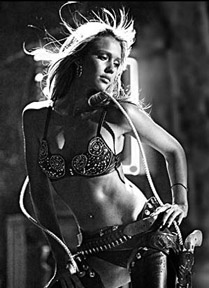 Jessica: Yeah, I just felt like I was a little pea, a little line in this music, this piece of music that was beautiful like from beginning to end. I wanted to rewind it and see the whole thing all over again, because I don’t think I got to really like have all the images that I want in my mind. There was so much, you know, it was so visual and overwhelming and all the characters were so specific. And it’s great.
Jessica: Yeah, I just felt like I was a little pea, a little line in this music, this piece of music that was beautiful like from beginning to end. I wanted to rewind it and see the whole thing all over again, because I don’t think I got to really like have all the images that I want in my mind. There was so much, you know, it was so visual and overwhelming and all the characters were so specific. And it’s great.
Robert: You can watch yourself?
Jessica: I’m critical of myself, so I’m waiting for my part to be over so I can get on with enjoying the movie. That’s sort of my thing. But you made my skin look nice. Thanks.
Q: Jessica, how did you prepare for this movie, as far as working out, learning the lasso, ant dancing that you did?
Jessica: I work out anyway just because it’s healthy to work out and women have health problems; especially in my family. So I work out just to be healthy anyway so that was already part of it. And I went to strip clubs to see how strippers do it, and I realized that; I wanted a choreographer and Robert said no, and I was like "Ahhhh, OK" and he’s like "Just feel it. We’re gonna play music and you’re just gonna feel it."
Robert: I wanted it to come from you. I did that with Salma Hayek in Dusk ‘Til Dawn. She wanted a choreographer, said "I don’t know how to dance." But, I’m not going to have you doing dance moves. I want something more primal than that.
Jessica: Mind you he’s saying Salma Hayek in ‘Dusk Til Dawn, the sexiest dance I’ve ever seen on camera ever. And he’s like, "It’ll be like that", and I was like, "Like that? Are you serious? I have to live up to something.” Like it’s iconic, there hasn’t been a sexier dance ever, and she wasn’t naked.
Robert: She was very nervous too.
Jessica: And she was gorgeous.
Robert: And she was just there. You do it and you go up there and I just knew; you know how to dance, it’s gonna be something people wish they could choreograph.
Jessica: He says that. My heart was beating so fast. I was so nervous. And then I had some Texans teach me how to rope and lasso.
Robert: She’s out there in the back ropin’ and spinning the gun. She whacked herself in the head a few times. By the time she got to the stage, we were just all watching. "Oh the tape ran out Robert". "Oh OK".
Q: Jessica, can you talk a little bit about how Fantastic Four is different? Then also say about Into The Blue?
Jessica: Fantastic Four couldn’t be more different. Fantastic Four is a family movie. I play a scientist who has a problem expressing her emotions, and her DNA was altered and when she does express her emotions she goes invisible. So when she’s screaming she goes invisible, when she’s having a melt-down she goes invisible, and she’s completely frustrated. And the man that she’s in love with ignores her and she goes invisible. So that’s very frustrating. It’s very big and it’s a huge movie for Fox and there’s a lot of pressure that it does well. So, it really couldn’t be more different. Into The Blue, I did that a long time ago. Jim Cameron has been sort of kind of talking about maybe doing a comic book that involves scuba diving. Fathom is sort of like this girl under water. I had been talking to him about possibly doing something like that, and this movie came up and I hadn’t scuba dived in seven months, and they were going to give me a decent paycheck to scuba dive in the Bahamas for five months, and I was like "cool". That’s honestly why I did that.
Q: How do you keep style from overwhelming the story?
Robert: The thing about the book is that they go hand in hand. I mean, to make a regular movie out of Sin City would have robbed it of how much the images worked on it. That’s what we loved about it, was that they were great stories on their own, but also the images are what really hit you first. So that’s the effective pattern. People see a trailer and they say, "This looks unbelievable" because the visuals in it, they’re not getting any story, they’re just getting the visuals. And so then you know it’s working. It goes hand in hand. That’s what’s so great about Frank’s books, and what’s made them so enduring and so astonishing in the comic world, is that they’re very complete as stories, very original as stories, but then the visual element is also just revolutionary. That’s why I wanted to make a movie out of it, because if I could put that on the screen, people have never seen that before. It’ll be a really new experience for them.
Q: Do the actors fear that it could overwhelm your performances?
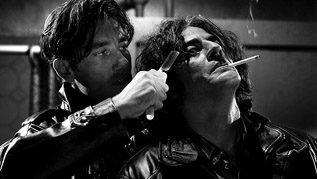 Benicio: No. I don’t know if I’m competing with palm trees and stuff like that, but I did feel like usually in movies, less is more. But in this movie, one of the reasons to do it, in some ways, was to do more is more. More over-the-top, what we call over-the-top, it’s conducive for that.
Benicio: No. I don’t know if I’m competing with palm trees and stuff like that, but I did feel like usually in movies, less is more. But in this movie, one of the reasons to do it, in some ways, was to do more is more. More over-the-top, what we call over-the-top, it’s conducive for that.
Robert: We used the images a lot, and he’d look at the panels and go, "OK, I get my hand cut off here, but in the next panel I’ve got the gun again. How did I get it out of my hand? Maybe I should go chew my fingers off the gun". They’re coming up with ideas to fill in the panels, and then "maybe I should take the hand and put it in my pocket.” I said "For later. Maybe someone can sew it back on.” We were laughing about that "for later.” That wasn’t in the book, but sort of in between the lines because the book jumps from panel to panel, and it was very creative for them to come up with things that help the story, fill in the story and filled in the characters. And the whole reason to shoot on green screen was to really strip away the backgrounds and the effects, to really make what was important important, which was the performances of the actors, and that’s how his comics are. Sometimes there’s just black behind an actor, I mean in the comic in the character. So that you’re really just looking at their eyes or the performance and the characters. You need to be what pops out more. That’s what people are going to walk away from here, is how unique Yellow Bastard is, or the Elijah Wood character and Jackie boy or Nancy. You’re thinking about the characters, you’re not thinking about all that other stuff.
Give pole dances on our message boards!
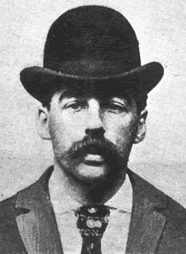 What the hell is a "horror documentary?" Seriously, I have no idea what that even possibly means. At first I thought a "horror documentary" was a documentary about horror. But then I found out that the "horror documentary" in question is about early serial killing pioneer HH Holmes.
What the hell is a "horror documentary?" Seriously, I have no idea what that even possibly means. At first I thought a "horror documentary" was a documentary about horror. But then I found out that the "horror documentary" in question is about early serial killing pioneer HH Holmes. 

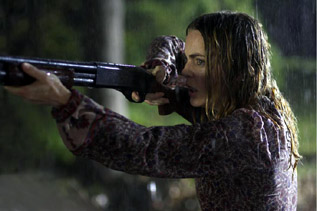 (
(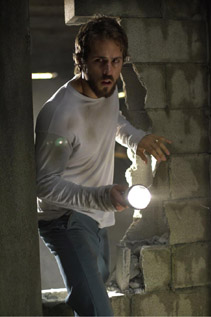 Pisani tells us that this is to facilitate the complex camera moves
Pisani tells us that this is to facilitate the complex camera moves 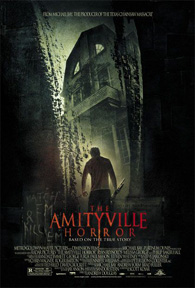
 (
( Robert: Yeah, it’s a great love story because he doesn’t realize she’s grown all those ages, she’s like the only person there for him while he’s in prison and he comes out. Frank got the idea cause he was at his mother’s house and there’s this beautiful woman walked in, and there’s the kitchen, and he’s like, “Oh my god,” then she turns around and says, “Hi, Uncle Frank!” And he’s like “Oh my god, my little niece is grown up.” He felt like such an idiot for looking at her but she became a woman in front of his eyes. He hadn’t seen her in years and that’s where he got the idea for. And I had some of that when I first met you, you came over to the set, you were like 16, she was kinda dorky, really kinda thin. And I was like, “She’s so cute.” And I was really looking at her cause she was an Alba and there were very few Latin actresses, and I was really watching her from then on hoping that she would still be around for another movie. And then, now she’s like, it’s almost like that feeling, I remember when she was [little].
Robert: Yeah, it’s a great love story because he doesn’t realize she’s grown all those ages, she’s like the only person there for him while he’s in prison and he comes out. Frank got the idea cause he was at his mother’s house and there’s this beautiful woman walked in, and there’s the kitchen, and he’s like, “Oh my god,” then she turns around and says, “Hi, Uncle Frank!” And he’s like “Oh my god, my little niece is grown up.” He felt like such an idiot for looking at her but she became a woman in front of his eyes. He hadn’t seen her in years and that’s where he got the idea for. And I had some of that when I first met you, you came over to the set, you were like 16, she was kinda dorky, really kinda thin. And I was like, “She’s so cute.” And I was really looking at her cause she was an Alba and there were very few Latin actresses, and I was really watching her from then on hoping that she would still be around for another movie. And then, now she’s like, it’s almost like that feeling, I remember when she was [little]. Benicio: I wasn’t familiar with the books. I was familiar with Frank’s work in Batman and stuff and since then, my preparation was really talking to the Wizard about— [Robert] got that nickname, I gave him that nickname. We just walked in and everything was green and I had seen how it looked already because he had shown me the beginning of the movie, the opening sequence. It was like being in the office of the Wizard of Oz thing.
Benicio: I wasn’t familiar with the books. I was familiar with Frank’s work in Batman and stuff and since then, my preparation was really talking to the Wizard about— [Robert] got that nickname, I gave him that nickname. We just walked in and everything was green and I had seen how it looked already because he had shown me the beginning of the movie, the opening sequence. It was like being in the office of the Wizard of Oz thing. Benicio: We had a great group of FX guys.
Benicio: We had a great group of FX guys.  Jessica: I’m not very experienced in theater. The only training I ever had was David Mamet’s theater company, the Atlantic Theater company. And that’s all I did was go on these little stages and imagine things, but they were in small rooms so the difference is you still had to shout and project your voice, but everything was little bit bigger and with Robert, it’s very specific. He fine tunes your performance so it’s kind of a marriage of film and theater I felt.
Jessica: I’m not very experienced in theater. The only training I ever had was David Mamet’s theater company, the Atlantic Theater company. And that’s all I did was go on these little stages and imagine things, but they were in small rooms so the difference is you still had to shout and project your voice, but everything was little bit bigger and with Robert, it’s very specific. He fine tunes your performance so it’s kind of a marriage of film and theater I felt. Robert: It just depends on how it grabs you. It’s got to be something that excites you. That’s why I pursued Frank just like a wild dog, trying to find him so we could do this movie. Because once I got into my head that this it was possible and I did a test and I saw what it was looking like, I knew I wouldn’t get this excited about another project for a long time. I had to hunt him down and find him and convince him somehow that we were going to do this movie, cause I could already see it and I wanted to do it, really bad. So, it just felt right. That’s why when people get in my way, the DGA goes "Oh you can’t do a movie like that," "Well I’m leaving". It’s like a train that’s rolling and everyone jump aboard ‘cause it’s just too new, it’s too right. And it feels like that way for other things. The Spy Kids movies as well. It was a way to do something about my family in a way that was entertaining, by just making them spies. My family as spies basically. The bad ideas and the ideas you don’t get excited about fall away, and the ones that come forward are the ones that get your blood pumping, that get your heart pumping. And the ones you can’t sleep until you do them, those are the ones that keep me up all night; keep me working.
Robert: It just depends on how it grabs you. It’s got to be something that excites you. That’s why I pursued Frank just like a wild dog, trying to find him so we could do this movie. Because once I got into my head that this it was possible and I did a test and I saw what it was looking like, I knew I wouldn’t get this excited about another project for a long time. I had to hunt him down and find him and convince him somehow that we were going to do this movie, cause I could already see it and I wanted to do it, really bad. So, it just felt right. That’s why when people get in my way, the DGA goes "Oh you can’t do a movie like that," "Well I’m leaving". It’s like a train that’s rolling and everyone jump aboard ‘cause it’s just too new, it’s too right. And it feels like that way for other things. The Spy Kids movies as well. It was a way to do something about my family in a way that was entertaining, by just making them spies. My family as spies basically. The bad ideas and the ideas you don’t get excited about fall away, and the ones that come forward are the ones that get your blood pumping, that get your heart pumping. And the ones you can’t sleep until you do them, those are the ones that keep me up all night; keep me working.
 Benicio: No. I don’t know if I’m competing with palm trees and stuff like that, but I did feel like usually in movies, less is more. But in this movie, one of the reasons to do it, in some ways, was to do more is more. More over-the-top, what we call over-the-top, it’s conducive for that.
Benicio: No. I don’t know if I’m competing with palm trees and stuff like that, but I did feel like usually in movies, less is more. But in this movie, one of the reasons to do it, in some ways, was to do more is more. More over-the-top, what we call over-the-top, it’s conducive for that. 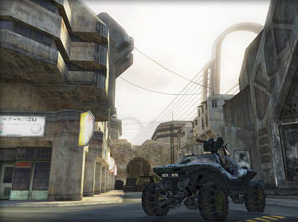 For weeks, rumors
For weeks, rumors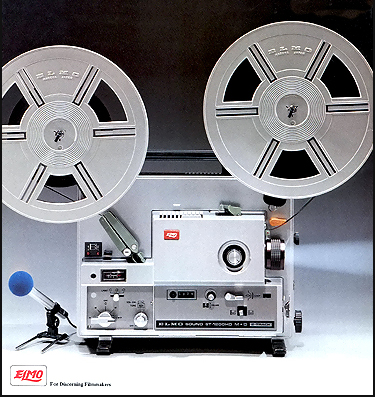 Catching a movie projected digitally can be a rewarding experience – the picture clarity and brightness is astonishing, and the pre-movie ads and trivia bullshit are often animated! And as Star Wars fans know very well, you may even see a different movie than the folks catching it on celluloid.
Catching a movie projected digitally can be a rewarding experience – the picture clarity and brightness is astonishing, and the pre-movie ads and trivia bullshit are often animated! And as Star Wars fans know very well, you may even see a different movie than the folks catching it on celluloid.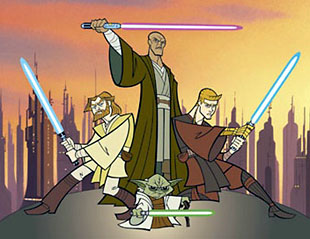 I didn’t catch any of the first Star Wars: Clone Wars animated shorts on the Cartoon Network, opting instead to wait for the eventual DVD release, and I’m glad I did because getting them in one somewhat cohesive package was a great way to see them.
I didn’t catch any of the first Star Wars: Clone Wars animated shorts on the Cartoon Network, opting instead to wait for the eventual DVD release, and I’m glad I did because getting them in one somewhat cohesive package was a great way to see them.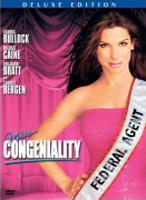

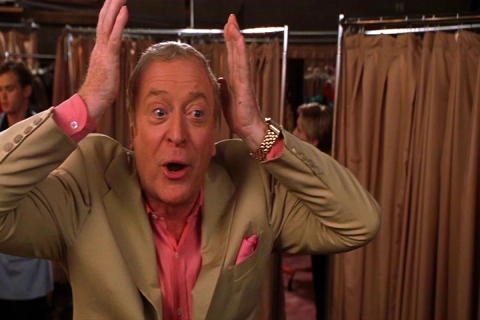
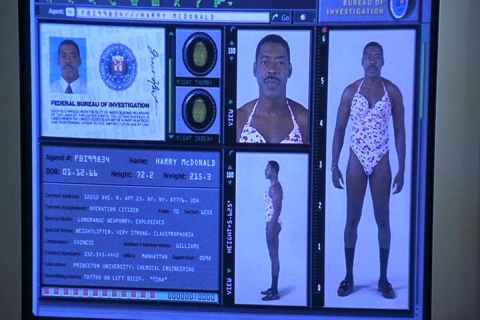
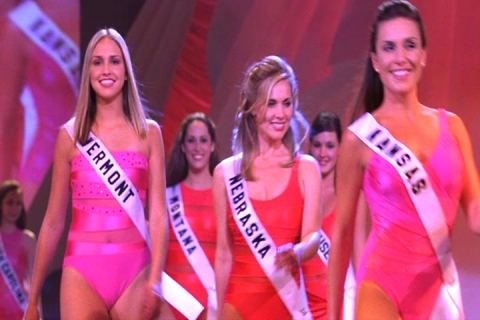
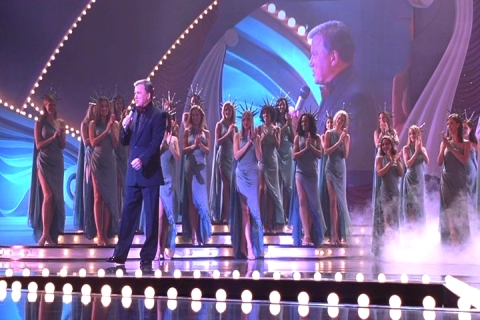
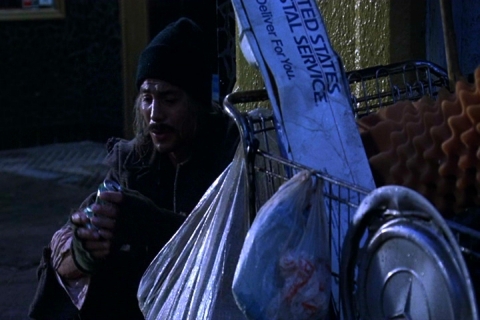

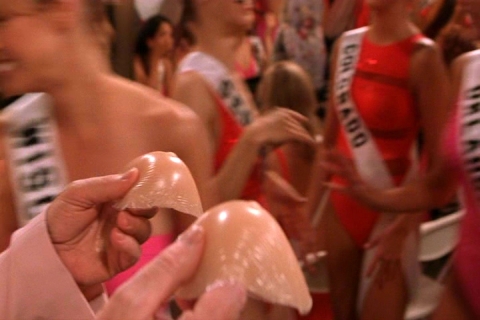
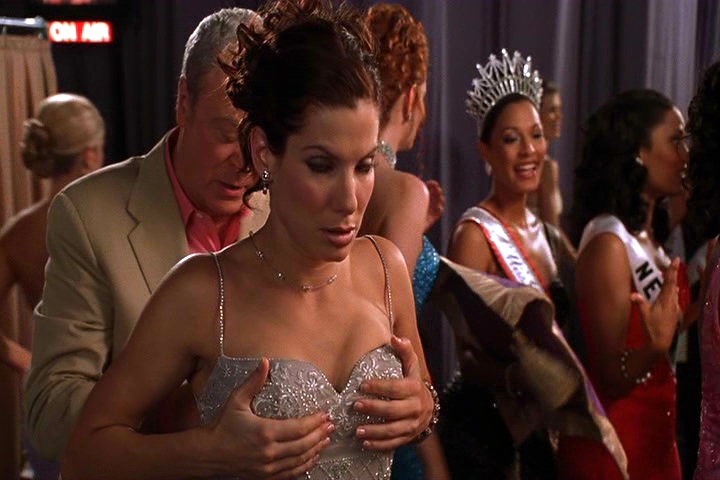
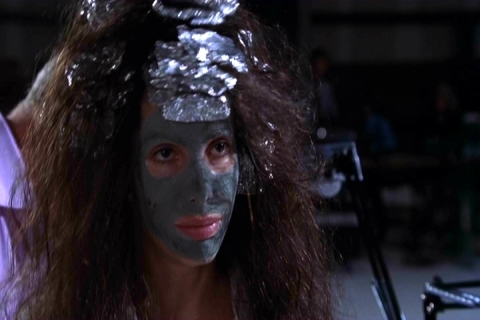
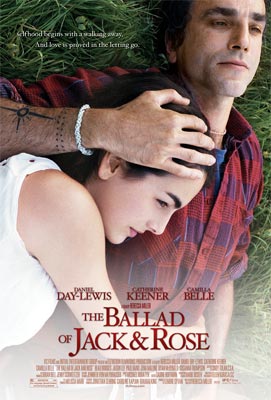 Devin had this to say about the latest Daniel Day-Lewis flick:
Devin had this to say about the latest Daniel Day-Lewis flick: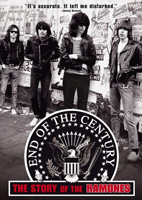
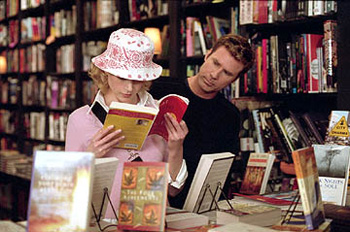 I don’t particularly like being a negative prick (sometimes) but I’ll be damned if
I don’t particularly like being a negative prick (sometimes) but I’ll be damned if